Blagdon Lake Birds
February 2014 News
Saturday 1st February [A bit wild at lunchtime but better later]
I thought I'd take a look around this morning before the weather turned and saw the Black-necked Grebe Podiceps nigricollis in Holt Bay and again later off the east end of Green Lawn. I saw 3 Mute Swans Cygnus olor out on Holt Farm fields eating grass, so I guess they are not finding enough aquatic weed to eat now. The geese were feeding on Rainbow Point but there wasn't much else to report.
Sunday 2nd February [Sunny but cool]
The Black-necked Grebe Podiceps nigricollis was showing nicely in Holt Bay at lunchtime, and rather unusually, the Canada Goose flock was at Ash Tree, where I could only see 13 Barnacle Geese Branta leucopsis. A pair of adult Great Black-backed Gulls Larus marinus were displaying to one another at Peg's Point.
Monday 3rd February [Overcast and windy]
I saw the Black-necked Grebe Podiceps nigricollis in Holt Bay at lunchtime, 16 Barnacle Geese Branta leucopsis with the Canadas, a Green Picus viridis and pair of Great Spotted Woodpeckers Dendrocopos major at Hellfire Corner, and an increase in the number of Common Pochards Aythya ferina. A flock of about 40 Northern Lapwings Vanellus vanellus flew east along the lake before I left.
This afternoon a RED-FLANKED BLUETAIL was found nr Marshfield by John Barnett - a great reward for another local patch worker.
Tuesday 4th February [Sunny spells but cold and windy]
Once again, not too much to report. The Black-necked Grebe Podiceps nigricollis was in Holt Bay again, and a third pair of Mute Swans Cygnus olor has arrived at the lake, ready to stake out their territory. I heard a Northern Raven Corvus corax call while I was sitting in Top End hide, which I can add to the year list now. I spent much of the early afternoon trying to get some pictures of the grebe, but the sun kept hiding behind the clouds nearly everytime it was close enough to press the shutter. It really does need sun to bring out the ruby red eye and lift a picture.
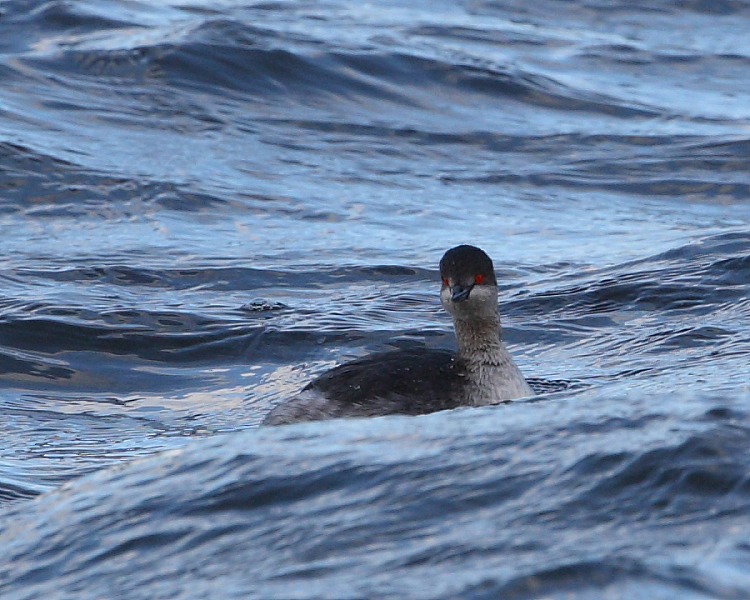
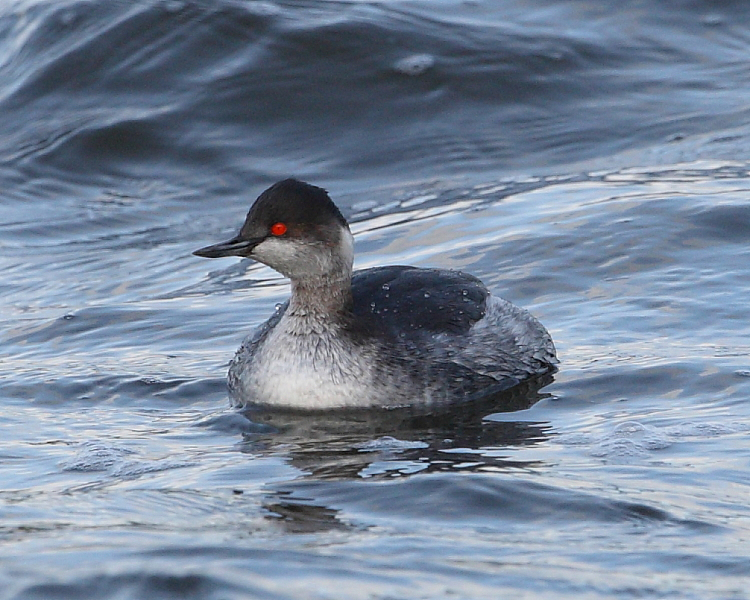
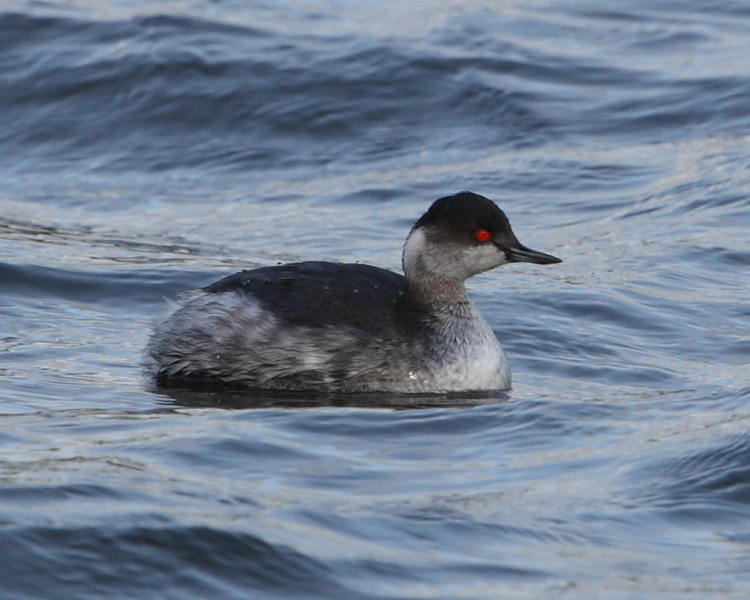

Wednesday 5th February [More flooding and gale force winds overnight]
Water is flowing over the road at the end of Long Bay instead of going under the bridge, most of the dabbling ducks, coots, swans and geese are feeding in the fields and Grey Herons Ardea cinerea are sheltering behind hedges out of the driving rain. I found the Black-necked Grebe Podiceps nigricollis in Holt Bay again this morning. This afternoon the gull roost was spread out along the North Shore facing into the southerly wind making viewing very difficult. I couldn't see any rares, but I did see the Common Sandpiper Actitis hypoleucos back on the dam - the first time since 14th January.
It doesn't look like I shall be out walking the SWCP anytime soon either, with the horrendous scenes being played out on the south-west peninsula.
Thursday 6th February [It's still raining]
A couple of hours at lunchtime saw the Black-necked Grebe Podiceps nigricollis feeding off the east end of Green Lawn and as I was about to come home for something to warm me, a blizzard of gulls dropped in to wash up. So I spent about an hour standing in the light rain going backwards and forwards through them hoping against hope for a 'white-winger' and yes folks I found one, an adult Mediterranean Gull Larus melanocephalus... It's a good job I'm a glass half-full kinda fella, or I might give up looking at Blagdon gulls!
Friday 7th February [A much nicer sunny day than of late]
I had a look at the lake late this afternoon and saw the Black-necked Grebe Podiceps nigricollis off Rainbow Point, the Common Sandpiper Actitis hypoleucos on the dam and 3♀♀ Goosanders Mergus merganser in Butcombe Bay.
I had been in Swindon earlier today, so dropped in on the way home and had a look at the Red-flanked Bluetail during the afternoon. It was showing beautifully, so I grabbed a couple of distant record shots.
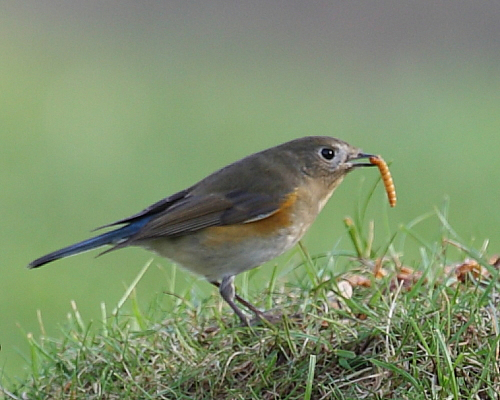
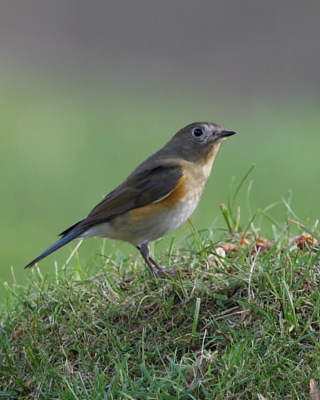
Saturday 8th February [Sunny spells and showers]
Our wintering Black-necked Grebe Podiceps nigricollis was back at the east end of Green Lawn again this morning, and I saw 19 Common Snipe Gallinago gallinago. Steve Hale suggested there appeared to be a few more Common Goldeneye Bucephala clangula around today and he could well be right, we usually get a build up in February. It's the WeBS count next weekend, so unless I count them beforehand, we'll find out then.
Sunday 9th February [Wintery showers]
The Black-necked Grebe Podiceps nigricollis was at the east end of Green Lawn late this afternoon and the gull roost contained a handful each of Lesser-Black-backed Larus fuscus, Herring L. argentatus and Common Gulls L. canus and at least 1000 Black-headed Gulls Chroicocephalus ridibundus.
I went on an excellent moth genitalia dissection workshop at Bristol Museum run by Mike Bailey and Ray Barnett today so didn't spend much time at the lake.
Monday 10th February [Mainly sunny with a biting wind]
The Black-necked Grebe Podiceps nigricollis was still present and feeding in Wood Bay at lunchtime, and saw an adult ♂ Goosander Mergus merganser at the head of Butcombe Bay briefly, where I was mooching around unsuccessfully trying to find a Eurasian Nuthatch. I drove down to the lake again late this afternoon to check the gulls, but there's nothing to report I'm afraid.
Tuesday 11th February [Mainly sunny]
I saw the Black-necked Grebe Podiceps nigricollis back off the east end of Green Lawn again late this afternoon and counted 11 Common Snipe Gallinago gallinago at Long Bay.
Wednesday 12th February [Wild and wet]
So, we've had the wettest January in recorded history and now we're getting battered by storm force winds every few days it's certainly taking its toll on the trees beside the lake. Another huge limb has been torn off a tree at Home Bay and an Elder bush has come down over the road requiring me to manually move it aside to get through. And once again, the road is flooded in several places as water pours into the lake. It's crazy!
The Black-necked Grebe Podiceps nigricollis was sheltering behind bushes with Common Pochard Aythya ferina at Holt Bay early afternoon, and a trip of 15 Common Snipe Gallinago gallinago flew in over my bonnet and landed at Top End. While putting out food at the Hatchery, a Common Kingfisher Alcedo atthis flashed past me, it's electric blue plumage dazzling against the brick red of the feeder stream.
When I went down at 1700 hrs to check the gull roost (aren't the evenings drawing out now) I found them all facing me into the wind and impossible to view. However, the wintering Common Sandpiper Actitis hypoleucos was tucked into the corner at Cheddar Water sheltering and showing quite nicely.
Thursday 13th February [Early snow flurries then sunshine]
Paul Williams spotted the (presumed wintering) Eurasian Bittern Botaurus stellaris again this lunchtime at Flower Corner, and despite my dash down to join him we didn't see it again. I spent a couple of hours combing the Top End east of Holt Copse, where I heard a Great Spotted Woodpecker Dendrocopos major drumming, but it was to no avail. The Black-necked Grebe Podiceps nigricollis was feeding off the east end of Green Lawn and I found a near summer-plumaged (white forehead) Mediterranean Gull Larus melanocephalus in the pre-roost off Butcombe Bank. Intriguingly, one of the fisheries rangers thought he'd seen a (White-throated) Dipper Cinclus cinclus at the Pumping Station stew ponds today, but until he's double-checked, I wouldn't rule out the Common Sandpiper Actitis hypoleucos for now. Still, it pays to keep an open mind...
Friday 14th February [Wet and very windy]
I only had time for the briefest of visits late this morning, mainly to fill the bird feeders. However, I caught a glimpse of the Eurasian Bittern Botaurus stellaris and the Black-necked Grebe Podiceps nigricollis was sheltering in Holt Bay. The easterly wind was crashing huge waves up the dam wall and would have been worthy of a picture or two, but I'd left my camera at home as I had to go to Swindon.
Saturday 15th February [Sunny spells and wintery showers]
There were stacks of gulls feeding on the lakeside fields this morning and flying to and from the lake to bathe. I have put some conservative estimates of Common Larus canus and Black-headed Gulls Chroicocephalus ridibundus into the WeBS Count, but they were very mobile and hard to even look through. We saw the Black-necked Grebe Podiceps nigricollis and counted 79 Common Snipe Gallinago gallinago, but there was no sign of the Eurasian Bittern.
Sunday 16th February [Spring-like, with ne'er a cloud in a blue sky]
I visited late morning to replace a bat box that we had to take down because the tree it was on was falling over, and while I was there I saw the Black-necked Grebe Podiceps nigricollis off the end of Rainbow Point. There were very few gulls in the roost, even by Blagdon standards, but I did count 32 Common Goldeneye Bucephala clangula from the dam - double the number I saw yesterday during the WeBS.
I don't know about anyone else locally, but we haven't been getting visits from Eurasian Siskins Carduelis spinus to our home bird feeders during the winter, but over the last 4 days I have seen at least one pair coming in regularly, as is often the case in spring. I had to 'shoo' the male off the feeder yesterday in order to take it down and refill it. I could have reached out and touched him!
I have been reading the 1947 Proceedings of the Bristol Naturalists' Society and came across the following note: "The very severe weather from January to March was not without its effect on bird life... At the reservoirs a gradual - finally a total- freeze up, with ice to a depth of six or seven inches, forced all but a very small number of duck to depart. A few grebes and a considerable number of Coot, however, stayed, and at Blagdon the latter were to be seen in droves eking out a precarious existence on adjoining pastures and even foraging round haystacks. At Blagdon, on February 16, Messrs. H.J. Boyd and B. King had the unique experience of finding specimens of all the British grebes present - the count being two Great Crested Grebes, one Red-necked Grebe, two Slavonian Grebes, four Black-necked Grebes and ten Little Grebes. Mr King reports that with two-thirds of the reservoir frozen, identification was comparatively easy, and that, with the exception of the Black-necked Grebes (seen about 30 yards out), the birds were viewed only a few feet away, swimming in very small, clear patches of water close under the bank. The same observer states that concealment on the part of Mr. Boyd and himself was quite unnecessary as the grebes, when trying to escape by diving, were obliged, owing to the extensive icing, to return each time to their respective patches of water, and that they had insufficient water space in which to take flight."
It's been very mild so far this winter, unlike nearly 70 years ago, but the Coots are having to feed out on the "adjoining pastures" this winter as well. The occurrence of 5 species of grebe at Blagdon hasn't happened in the 20 years or more that I've been watching the lake intensively, though I was lucky enough to see all 5 species in Portland Harbour, Dorset, while the Brunnich's Guillemot was there last December.
Monday 17th February [Another miserable, wet, day]
I went to buy some more bird food this afternoon and after putting some out at the Hatchery, birded my way back along the lake. I was delighted to see that a small flock of geese had come over from Chew with the 2 adult Pink-footed Anser brachyrhynchus and 15 Barnacle Geese Branta leucopsis among the Canada's Branta canadensis. The Black-necked Grebe Podiceps nigricollis was off the east end of Green Lawn and I saw the Eurasian Bittern Botaurus stellaris hunkered down in the rain. A check through the gulls on the fields didn't even produce a Med.
Tuesday 18th February [Sunny and mild]
Today the Black-necked Grebe Podiceps nigricollis was feeding around Rainbow Point where, perchance, the 2 adult Pink-footed Geese Anser brachyrhynchus were also feeding with 21 Canada Geese Branta canadensis. I was hoping to get some half decent pictures of the geese in the sunshine but they were pretty wary and spooked by the passing fisheries traffic on more than one occasion. Mike Gillett spent some time at the Hatchery feeders, where I met him, but he didn't have any positive news on the Eurasian Nuthatches. It seems like the one reliable spot for seeing them at the lake is no longer occupied. We did see a Common Kingfisher Alcedo atthis fly past, and he saw a couple of Eurasian Siskins Carduelis spinus before I got there.
Wednesday 19th February [Wet again]
I met Roger and Jean Staples when I arrived at the Lodge and they told me they'd seen the Black-necked Grebe Podiceps nigricollis feeding off the east end of Green Lawn, which is where I saw it later too. Roger commented that its just starting to assume summer colours, so if it hangs around for another month or so, we might see it moult into summer plumage before it departs. There was no sign of the Pinkies or Eurasian Bittern today, but Roger and Jean had just left me when I spotted a full summer-plumaged Mediterranean Gull Larus melanocephalus on the other side of the lake in the mouth of Butcombe Bay.
Thursday 20th February [Wet early, better later on]
After a site meeting with Sophie Edwards, BW Environment Officer, regarding the siting of some more bat boxes at the Pumping Station, I had a quick look around and saw the Black-necked Grebe Podiceps nigricollis at the east end of Green Lawn. I saw 6 Stock Doves Columba oenas around the Home/Long Bay area and with the onset of more settled weather this week, the Rooks Corvus frugilegus have been busy in the Home Bay Point rookery. Again, there was no sign of the Eurasian Bittern or Pink-footed Geese today.
Friday 21st February [Sunny morning with rain later]
This afternoon, the Black-necked Grebe Podiceps nigricollis was showing very well at the east end of Green Lawn and you could see it has grown its golden ear coverts since I photographed it on 4th February. However, the neck is still grey and it has a way to go before it reaches full breeding dress.
I've just received an email from Sophie Edwards confirming that we can go ahead and replace the barn owl boxes which have taken such a pounding. One has no roof and both have become unusable, so I'll be putting the money I've earned giving my Blagdon Lake talk during the autumn and winter towards the project. Many thanks to all of you who have come along and supported. I was planning to use the fees towards putting up roost boxes inside the bat house but, thanks to Daniel, we have obtained some boxes / tiles and will be putting these up when we can get back into the building - a problem with the door swelling meant we had no access this winter in order to check to see if it's being used, or to carry out the work.
Saturday 22nd February [Sunny]
After the rugby, I went to look at the gull roost but there was nothing unusual to report - unlike the amazing events at Chew.
Paul Williams has texted to say he'll put up £100 to complete funding of the two new barn owl boxes. Cheers for that Paul. Keith and Linda Hall of Specialised Nest Boxes are going to make the boxes and provide a new pole for the North Shore, and Keith and I will put them up when I get back from Trinidad & Tobago where I'm going on Monday on the Trinibats 2014 research tour. I will be providing news updates if people send me emails of their sightings and will run a daily diary from Trinidad on my photo website.
Sunday 23rd February [Strong southerly breeze and overcast]
I was up before sunrise this morning hoping to connect with some of the Chew gulls flying west down the Yeo valley towards the coast, but nothing came through. There were 2000+ Common Larus canus and Black-headed Gulls Chroicocephalus ridibundus on the lake and adjoining fields with just a single adult summer Mediterranean Gull Larus melanocephalus among them. The wait for my first BL Glaucous Gull goes on!
The Black-necked Grebe Podiceps nigricollis was in Holt Bay as usual, and there was a singing ♂ Reed Bunting Emberiza schoeniclus in Long Bay (the first of the year).
Monday 24th February
No news from the lake today. I flew out to Trinidad for a few days birding before the start of the Trinibats 2014 research trip.
Tuesday 25th February
No news from the lake.
I birded around the Hacienda Jacana in Talparo, Trinidad. Then, in the evening went to Caroni Swamp to see the Scarlet Ibises (the national bird) come in to roost. I managed 8 new Trini birds and got a distant shot of an, as yet, unidentified raptor.

Wednesday 26th February
No news from the lake.
I spent the early morning birding from the verandah overlooking the lake, then mid-morning went up to Asa Wright Nature Centre for the day. I got a couple of new hummers, Green Hermit and Long-billed Starthroat as well as Bearded Bellbird, which I didn't see last year. Then, when I got back to Hacienda Jacana I saw a ♂ Crimson-crested Woodpecker to add to the growing island list. As it got dark, I recorded some bats that were flying around the lake and spot-lighted a couple feeding over the lake, where the glowing eyes of a Spectacled Caiman reflected back at me. I also found some roosting bats on the side of the guest houses under the eaves. Tomorrow I fly over to Tobago for a few days, where I hope to photograph some nectar-feeding bats in flight visiting hummingbird feeders and visit some wetland areas with bird guide Newton George.
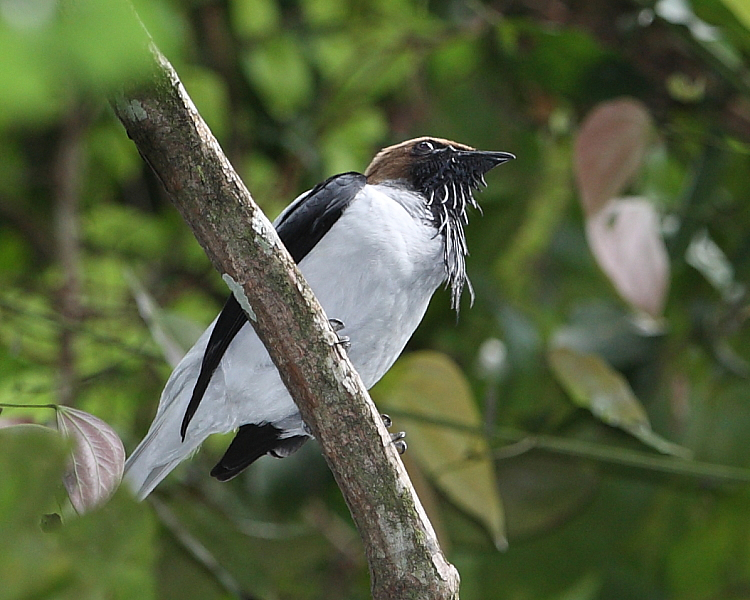
Thursday 27th February
No news from the lake.
I got up early this morning to photograph some roosting bats on the outside of one of the villas at Hacienda Jacana. They are either Greater or Lesser Sac-winged Bats, so-called because the males have sacs on the forearms. I found this extract from a paper which goes some way to explaining the presence of the sacs as follows: "Male Saccopteryx bilineata possess a sac-like organ for the storage and display of odoriferous secretion in their front wing membrane. Since males use the scent in agonistic and courtship activities, and compose it from different secretions of distinct sources, like saliva, urine and gland secretion, we hypothesized that multiple information is encoded in the male scent-profile. We expected that the odour profile of males varies seasonally, giving information on male reproductive status. In addition, the odour profile ought to vary between individuals, thus providing the possibility for individual recognition. We repeatedly collected samples from wing-sac liquids of 20 male S. bilineata in five Costa Rican colonies during the mating and non-mating season. Samples were analysed by gas chromatography coupled to mass spectrometry to compare wing-sac contents. Wing-sac odours included various substances such as carboxylic acids, terpenoids and aromatic compounds. Male scent profiles varied (1) between seasons in the relative amount of tetradecanoic and octadecanoic acid, and (2) between individuals in the relative amount of two species-specific substances. These results suggest that the wing-sac liquid of male S. bilineata is indeed a composite trait and may be useful for the simultaneous transfer of multiple information." The Wing-Sac Odour of Male Greater Sac-Winged Bats Saccopteryx bilineata (Emballonuridae) as a Composite Trait: Seasonal and Individual Differences, Chemical Signals in Vertebrates 11, 2008, pp 151-160. Barabara Caspers, Stephan Franke and Christian C. Voigt.


We had to make an early start to get to the airport to ensure we got on the plane for the short 25 minute flight to Tobago. All flights and ferries were fully booked due to 'Carnival' this coming weekend. After a bit of shopping on the way from the airport, we arrived at our self-catering accommodation at Adventure Eco Villas. A short walk in the garden this afternoon produced most of the usual suspects I've become accustomed to on T&T, but I did add Trinidad Motmot, Red-crowned Woodpecker, Rufous-tailed Jacamar and 5 Rufous-vented Chachalacas to the trip list, and had great views of lots of hummers and other garden birds at Ean Mackay's wonderful patio feeding station.
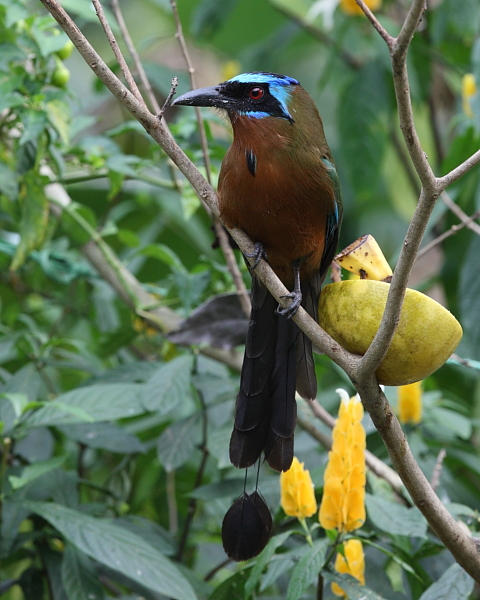
After dark I tried a new set up with a view to photographing nectar-feeding bats at the same feeders the hummers had been using earlier. Having had a chance to suss it out this evening, I'll be better prepared tomorrow - and will get set up well before dusk!
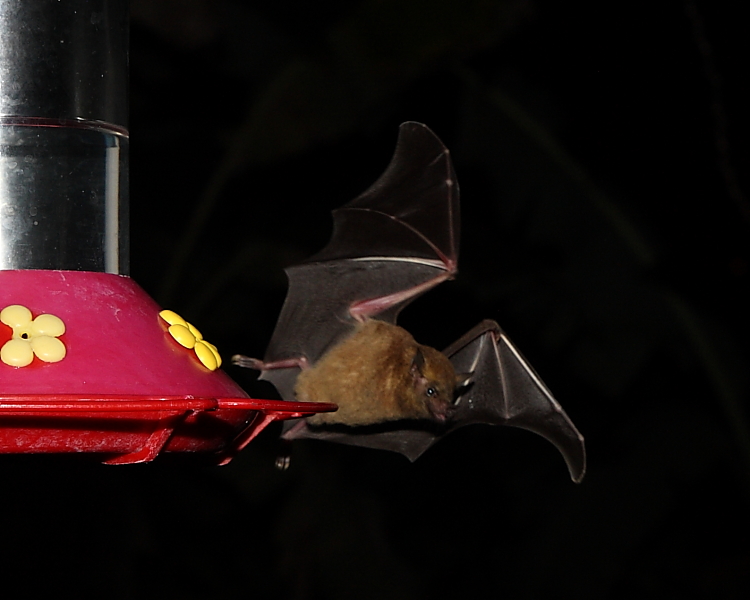
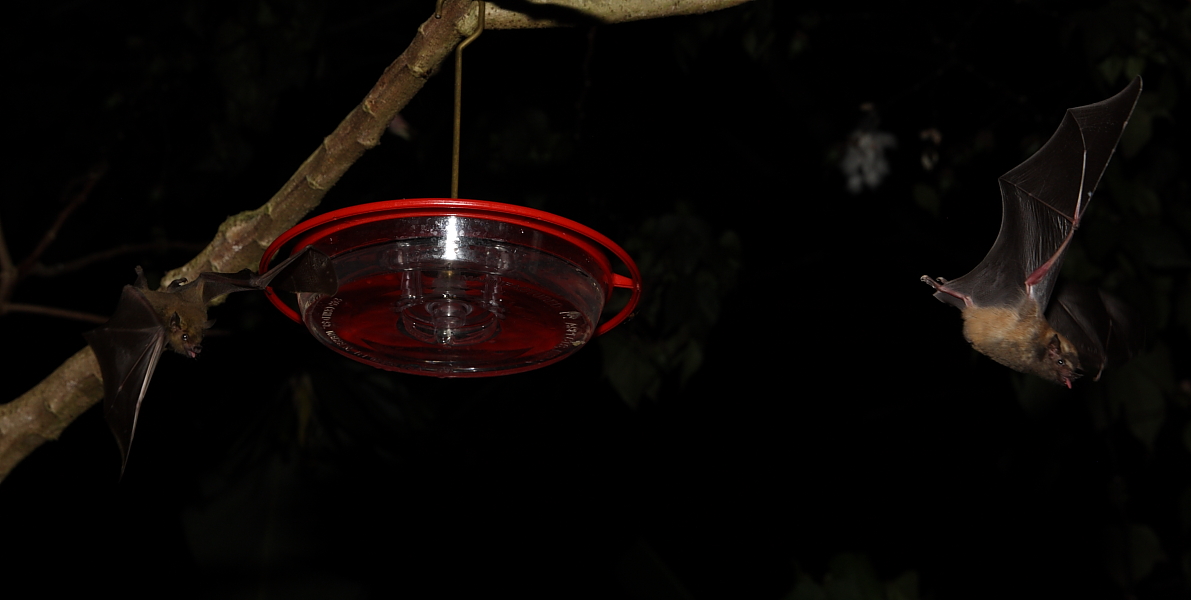
Friday 28th February
Again, I've had no news from the lake to share.
I spent the day pottering around the grounds of our accommodation in Tobago and had home-made mango ice cream for lunch! I added White-fringed Antwren to my life list and got this shot of a ♀ from the bedroom 'window' (no glass):
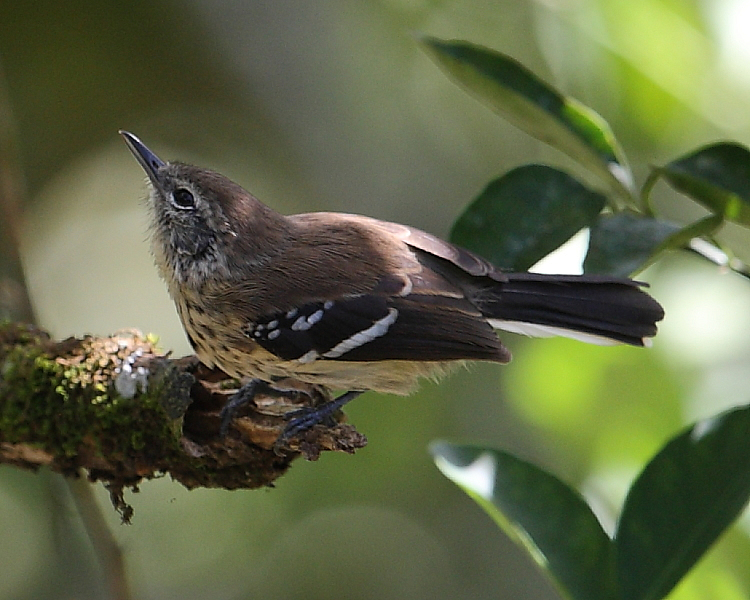
A presumed juvenile Red-crowned Woodpecker came in to the feeding station allowing me to get this shot:
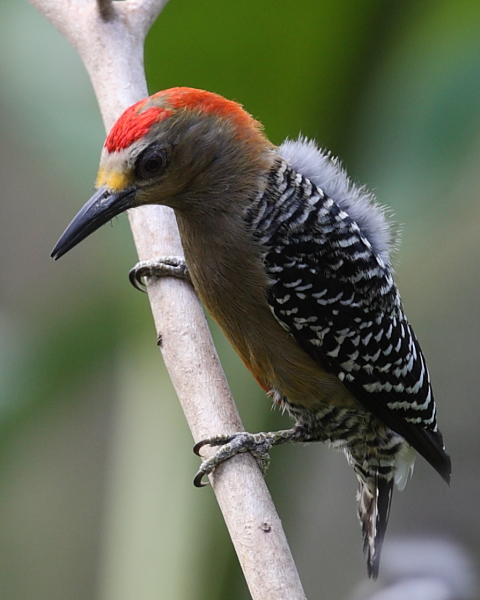
And the Rufous-vented Chachalacas came back into the same fruit tree I saw them in yesterday so got this from the balcony:
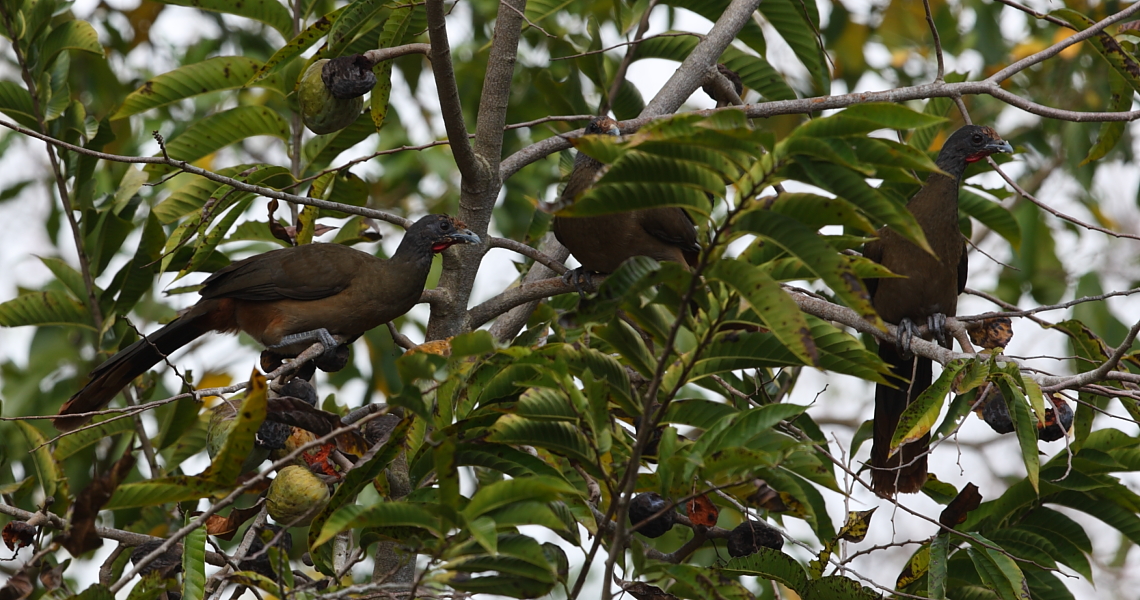
In the evening I set up a 24-70mm zoom lens up with two slave flash guns trained on a carefully selected hummingbird feeder and used a master unit on the camera with remote wireless shutter release. Amazingly, no bats came to that feeder! The flash units send out 1 second infra-red pulses which I assume put the bats off. I tried changing the design of feeder but this didn't work either. So, reluctantly, I went back to a single flash gun on the camera, using the wireless shutter release. This seemed to be acceptable to the bats, so it's what I'll use again tomorrow, but will raise the camera viewpoint above the feeder. It's a learning experience...
